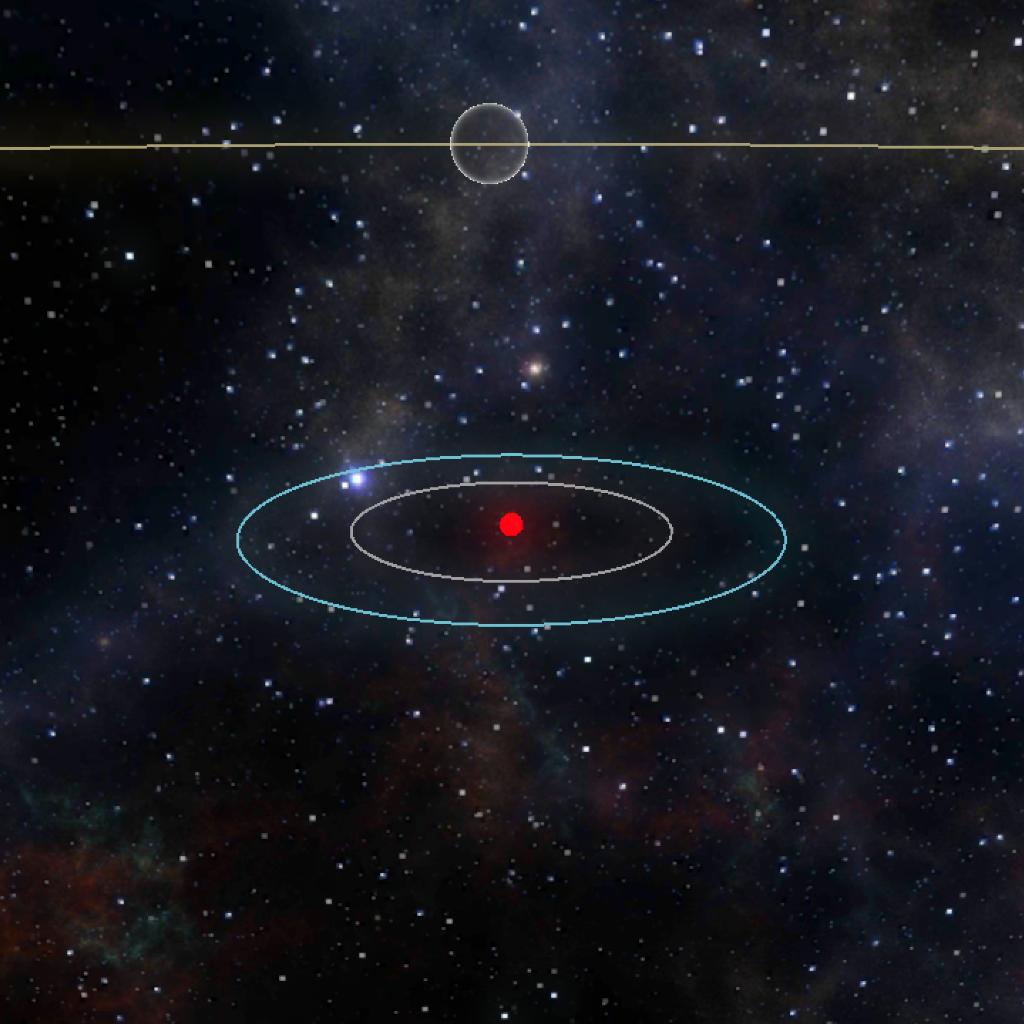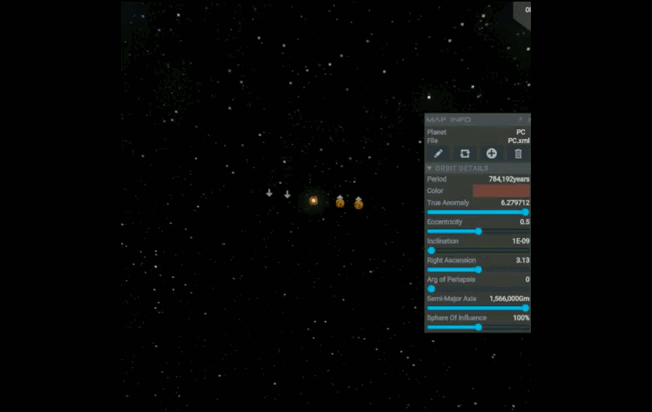The system is implemented on a real scale
the Alpha Centauri AB system is not coplanar with the orbital plane of Proxima Centauri around Alpha Centauri AB.
The kinematic characteristics of Proxima Centauri differ from those of the main stars of the system. Proxima is separated from a Centauri AB on the celestial sphere by an angular distance of about 2°, which is 4 times the angular diameter of the Moon. Proxima Centauri (Latin proxima - “nearest”) is located approximately 15,000 ± 700 AU. (about 0.21 light years) from the two central stars of the system. Proxima's orbital period around a Centauri AB is approx. 500 thousand years.
Coordinates of a Centauri A:
right ascension a2000 = 14h39m36s.5,
declination d2000 = -60°50'02?.
Coordinates of a Centauri B:
right ascension a2000 = 14h39m35s,1,
declination d2000 = -60°50'13?.
Characteristics of the components of the a Centauri system
a Centauri A a Centauri B Proxima Centauri
Absolute magnitude 4.38 5.71 15.53
Spectral class G2V K1V M5.5Ve
Luminosity (solar) 1.519 0.5 6·10-5
Diameter (solar) 1.227 0.865 0.14
Distance to the Sun, St. years (1) 4.36 4.22
(1) (the time that light travels to the Sun is taken into account, and not vice versa, and taking into account the bending of light under the influence of the center of our galaxy and other objects)
The relative positions of the Sun, Alpha Centauri and Proxima Centauri (the gray dot under “Alpha Centauri AB” is a projection of the position of Proxima Centauri at the same distance from the Sun as Alpha Centauri)
Observations
edit
The main stars of system A and B are too close to each other to be distinguished with the naked eye, since the angular distance between them varies between 1.7 and 22 arcseconds[28] but, due to the elongation of their orbits, both stars are easily distinguishable by small (lens diameter about 5 cm) telescopes[29].
In 2010, the angular distance between the components was 6.74 arcseconds, in 2011 - 6.04 arcseconds. The angular distance between the components became minimal (4 arcseconds) in February 2016. The greatest angular distance between the components of the system was last observed in February 1976, the next one will occur in January 2056.
In the southern hemisphere, Alpha Centauri forms the outer star of the Signposts, or Southern Signposts (navigational asterism),[29] so named because the line through Beta Centauri (Hadar, Agena)[30], 4.5° to the west[29], points straight to the constellation Southern Cross[29]. “Indicators” easily distinguish the real Southern Cross from the False Cross[31].
South of latitude -29°30' the star Alpha Centauri is a non-setting star[32]. Among the cities where it never goes beyond the horizon are Santiago, Montevideo, Buenos Aires, Porto Alegre, Cape Town, Canberra, Sydney, Melbourne. Like the Southern Cross, this star is located too deep in the southern hemisphere sky to be observed from mid-northern latitudes. On the territory of Russia and the former USSR in general, it does not rise anywhere, not even in Serkhetabad. South of latitude +29°10' (that is, south of Delhi, Kuwait and Houston) and to the equator, Alpha Centauri is visible low above the horizon in the south during the northern summer[30]. The upper culmination of the star occurs annually at midnight on April 24 or at 21:00 on June 8[30][33].
Planetary system
edit
As of March 2022, one confirmed and three unconfirmed exoplanets are known in the system. A large amount of detailed information about this system is expected in the coming years, from its examination by new telescopes: the already operational JWST, the planned Toliman and others.
Alpha Centauri A b
edit
In February 2021, the exoplanet candidate Alpha Centauri A b was discovered near Alpha Centauri A in the habitable zone with an orbital radius and period approximately equal to Earth's, the confirmation (or refutation) of whose existence has yet to occur.
Alpha Centauri B b
edit
Observations for a long time could not detect planets in the Alpha Centauri system [34] [35]. Only on October 16, 2012, astronomers at the European Southern Observatory announced the discovery of the planet Alpha Centauri B b with a mass close to Earth in orbit around a Centauri B[36][37]. The planet was discovered by measuring radial velocity fluctuations using the HARPS spectrograph. For this, astronomers needed more than four years of observations[38]. The Geneva team observed the spectrum of the star Alpha Centauri B from February 2008 to July 2011. A total of 459 radial velocity measurements were made; the accuracy of a single measurement was 0.8 m/s. This large amount of accumulated data has made it possible to identify and account for various sources of noise: stellar fluctuations (the surface of the star Alpha Centauri B oscillates slightly with periods of less than 5 minutes), surface granulation, the influence of sunspots on the star's average radial velocity, long-term activity associated with the magnetic field, and etc. The matter was partly made easier by the fact that the brightness of Alpha Centauri B, like many other orange dwarfs of spectral types K0 V and K1 V, is extremely stable. It was believed that planet b is very close to the star, at 0.04 AU. (6 million km) without falling into the habitable zone. Reversal periodThe orbit around the star is estimated at 3.236 days, and the minimum mass of the planet is about 1.13 Earth's.
In October 2015, the planet was “closed” (that is, declared non-existent), since it was proven that the 3.26-day RV signal in the measurements of the Geneva group appeared due to the peculiarities of mathematical data processing [39][40].
Proxima Centauri b or Alpha Centauri C b
edit
On August 12, 2016, the magazine Der Spiegel reported the discovery of the planet Proxima Centauri b in the habitable zone of the red dwarf Proxima Centauri[41]. On August 24, 2016, this information was confirmed by employees of the European Southern Observatory[42].
Proxima Centauri c or Alpha Centauri C c
edit
Proxima Centauri c is an unconfirmed planet located well beyond the habitable zone. Opened in January 2020.
Proxima Centauri d or Alpha Centauri C d
edit
Proxima Centauri d is an unconfirmed planet (mini-Earth) with a mass =0.26±0.05 Earth masses (a quarter of the Earth's mass, twice the mass of Mars), located closer to the habitable zone. Opened in 2020[43].
Other possible planets
edit
The proposed planets may orbit separately around a Centauri A or a Centauri B or Proxima Centauri, or may have large orbits around the binary system a Centauri AB[44][45]. Because both stars are approximately similar to the Sun (such as in age and metallicity), astronomers are particularly interested in finding planets in this system. Several teams that have announced research in this direction are using various radial velocity or stellar transit methods to study this system [34].
Computer modeling showed the possibility of planet formation within 1.1 AU. (160 million km) from a Centauri B, and that the orbit of this planet can remain stable for at least 250 million years[46]. Bodies around star A may orbit at slightly greater distances due to the stronger gravity of star A. In addition, the absence of brown dwarfs and gas giants around A and B, on the contrary, increases the chances of discovering terrestrial planets[47]. As of 2002, technology did not allow the detection of terrestrial planets around Alpha Centauri[47]. But theoretical calculations of the detection capabilities of the radial velocity method showed that targeted and regular surveys with a class 1m telescope[clarify] could with a high probability detect a hypothetical planet with a mass of 1.8 Earth masses in the habitable zone of a Centauri B within three years[48].
Based on Hubble Space Telescope observations in 2013 and 2014 of the star Alpha Centauri B, scientists have suggested the possibility of the star having a planet roughly the size of Earth, orbiting Alpha Centauri B in less than 20.4 days.[49][50]
One 2012 study by astronomers at the University of Edinburgh shows that the star a Centauri B has a habitable zone at a distance of no less than 0.5 and no more than 0.9 AU. from the star [source not specified 1591 days]. In this case, the average surface temperature of a hypothetical planet within this zone will differ by only 4-5 kelvins, depending on the distance to the second star a Centauri A. Modeling shows that a planet orbiting a Centauri B will approach the star a Centauri A to the distance at which this star will influence the climate of the planet. The rest of the time it will not have an impact on the planet’s climate. The researchers also note that such scenarios are possible only if there are oceans on the planet similar to those on Earth. If the planet is a dry desert, like Mars, then temperature fluctuations will be much stronger[51].
In 2019, using the thermal infrared coronagraph NEAR (Near Earths in the AlphaCen Region), installed on one of the four 8.2-meter telescopes of the Very Large Telescope complex of the European Southern Observatory in Chile, the search for planets in the Alpha Centauri system began in " habitable zone" for stars A and B[52]. After nearly 100 hours of observing with the VISIR spectrometer at sub-10 micron infrared wavelengths and removing spurious signals, the final image revealed light source "C1", which could be the Neptune-sized exoplanet Alpha Centauri A b within the habitable zone or a dust disk[53 ].
Interstellar flights
edit
It is assumed that Alpha Centauri will become one of the first targets of interstellar flights. It is impossible to overcome the distance between the Sun and a Centauri using modern technologies in a reasonable time. However, the capabilities of solar sail or nuclear rocket engine technologies may allow such a flight to be accomplished within several decades[54][55]. In 2016, it was announced that preparations had begun for the flight of a “nanosatellite on laser sails” (Breakthrough Starshot) to Alpha Centauri, which could cover the distance to the nearest star in 15 years[56].
The closest environment of a star
edit
Nearest environment of the Sun
Next star systemsThese are located within 10 light years of the Alpha Centauri system:
Star Spectral class Distance, St. years
Luhmann 16 AB L7.5 / T0.5 3.68
Sun G2 V 4.37
Barnard's Star M4.0 V 6.5
Ross 154 M3.5 Ve 8.1
Wolf 359 M5.8 Ve 8.3
Sirius AB A1 V / DA2 VII 9.5
Epsilon Eridani K2 Ve 9.7
GENERAL INFO
- Created On: Android
- Game Version: 1.2.109.0
CELESTIAL BODIES
| Name | Parent | Radius | Surface Gravity | Apoapsis | Periapsis |
|---|---|---|---|---|---|
| center | 1,000 m | 247,900,000,000.00 km/s | - | - | |
| center2 | center | 1,000 m | 247,900,000,000.00 km/s | 2,349,000,000.0 Mm | 783,000,000.0 Mm |
| Beta Centauri | center2 | 640.0 Mm | 230.0 m/s | 5,446,770.4 Mm | 1,815,590.1 Mm |
| Beta centauri B B | Beta Centauri | 1,382 km | 5.0 m/s | 7,381.3 Mm | 7,366.6 Mm |
| Alpha CENTAURI | center2 | 700.0 Mm | 250.0 m/s | 5,463,321.7 Mm | 1,821,107.2 Mm |
| Alpha Centauri A B | Alpha CENTAURI | 49,000 km | 24.8 m/s | 195,392.1 Mm | 195,001.7 Mm |
| PC | center | 380.0 Mm | 190.0 m/s | 2,349,000,000.0 Mm | 783,000,000.0 Mm |
| proxima Centauri D | PC | 2,890 km | 2.0 m/s | 5,062.3 Mm | 5,052.1 Mm |
| proxima Centauri B | PC | 6,780 km | 7.0 m/s | 8,592.7 Mm | 8,575.5 Mm |
| Proxima Centauri C | PC | 14,000 km | 24.8 m/s | 268,657.6 Mm | 268,120.8 Mm |









i like how you designed it @Yzelok